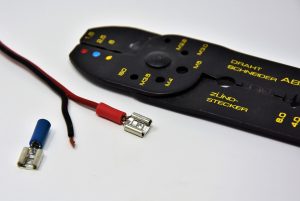
Both crimping and soldering are used to create connections for cables. Ethernet cables, for example, typically feature RJ-45 connectors at the ends. To add an RJ-45 connector to an Ethernet cable, you can either crimp or solder it. While both methods can produce high-performing, long-lasting cable connections, though, they aren’t necessarily the same
What Is Crimping?
Crimping involves the use of a special tool, known as a crimping tool, to install a connector on the end of a cable. To install a connector on a cable using a crimping tool, you place the connector into the tool. Next, you place the exposed wire at the end of the cable into the connector. Finally, you squeeze the handle of the crimping tool, at which point the connector will be joined to the cable.
What Is Soldering?
Soldering, on the other hand, is a process that involves joining two or more objects using heated metal known as solder. Unlike with welding, the objects — which in this case is a cable and a connector — is not heated. Rather, soldering only heats up the filler metal. As the filler metal, the solder, heats up, it’s applied between the wire and the connector. Once it cools, the solder hardens, thus joining the cable to the connector.
Archeological evidence suggests that soldering has been around for thousands of years, with some of the first known examples occurring in Mesopotamia over 5,000 years ago. Since then, it’s been used in a wide variety of applications, including the production of jewelry, computer repairs, creating stained glass, cookware and cable connections.
Why Crimping Outperforms Soldering for Cable Connections
For cable connections, crimping typically outperforms soldering for a few key reasons. First and foremost, cable connections last longer when they are crimped because they are protected from the intrusion of moisture, dirt and debris. Crimping tools are designed to create an air-tight seal between the cable and the connector. Therefore, moisture, dirt and debris won’t be able to reach the crimped cable. Soldering, unfortunately, doesn’t offer this same level of protection.
Crimping offers stronger, more reliable connections than soldering. Soldering uses heated metal to join the cable to the connector. Over time, this filler metal will degrade, which may cause the connection to fail.
Most electricians will agree that crimping is also easier than soldering. Soldering isn’t particularly hard, but it still requires heating the solder and carefully placing it between the connector and the cable. Crimping is an even easier process that involves requires placing the cable and connector into the crimping tool and squeezing the handle.
